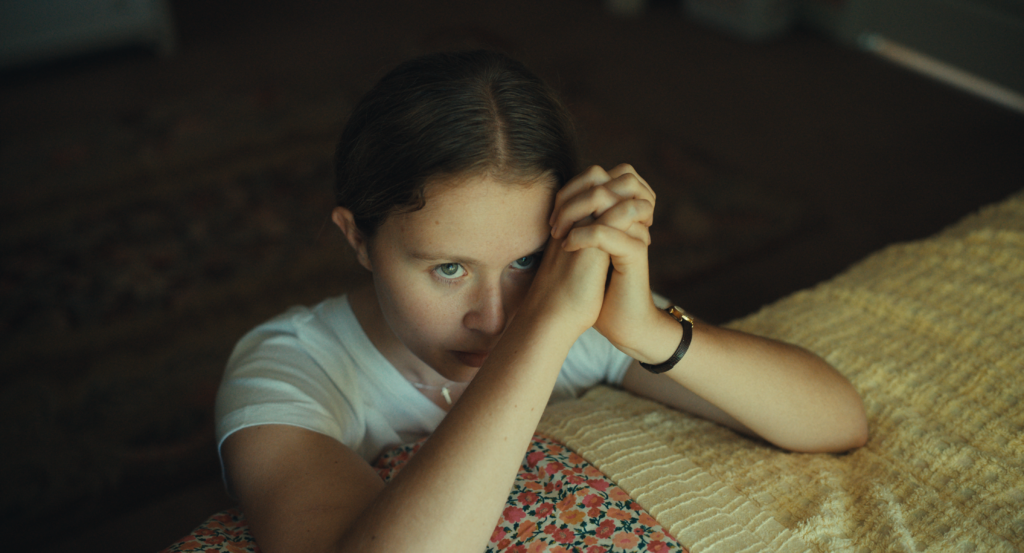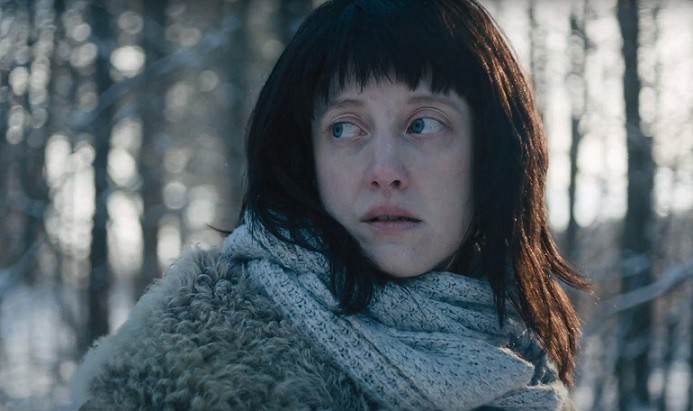Actress/writer Sophia Takal’s directorial debut, Green, is a film that is both dark in its themes of jealousy, yet shines with a natural ease depicting the burgeoning friendship of two very different women. Green focuses on a young Brooklyn couple, Sebastian (Laurence Michael Levine) and Genevieve (Kate Lyn Sheil) who come out to a cabin in the woods where Sebastian is going to cover gardening and country life for his hipster blog, a city mouse meets the country sort of feel. Genevieve puts up with Sebastian’s pretentiousness because she doesn’t have a secure identity of her own, and it takes the friendship of Robin (Takal), a local woman, to bring out her confidence. But though Genevieve and Robin share an ease with one another, it slowly twists into a dark path in Genevieve’s mind, when she concocts cheating fantasy scenarios between Sebastian and Robin that threaten to destroy her relationships.
Green is slow-moving, and despite its dark moments, has a light and lush beauty to it, thanks to the gorgeous cinematography and long takes captured in wide camera angles, that really give the audience a chance to walk with the characters and understand them from the inside out. I spoke with Takal via phone, after Green had played at BAM’s BAMCinemaFest.
Women and Hollywood: : The title of the film has a double meaning, to both indicate nature and jealousy. How did you develop the story?
Sophia Takal: The story came up in an outline one night. I knew that I wanted to shoot with the other two actors (Sheil and Levine), and I had that house for location because it was my dad’s house. I wanted to explore jealousy, and the emotions that I’ve been going through my whole life, really intensely in the year before shooting Green. And the last movie I made, Gabi on the Roof in July, was all in New York City. I wanted to get out of New York and into nature; I thought that would be really nice. The plot itself just came out of nowhere. It was based on some themes that I had been sort of playing around with.
WaH: The cinematography was absolutely lush and gorgeous. How did you and Nandan Rao get together to collaborate?
ST: He had shot another film called Bummer Summer. Both Bummer Summer and Gabi on the Roof in July premiered at a festival in California called Cinequest, and we became friendly and stayed in touch. I love the way that it was shot. He’s really talented. And [I was using] the Canon 5D, and a lot of people said that it was hard to focus with. But I knew that Nandon knew the camera really well. But mainly he’s really talented, and more than being just a D.P. He was really patient with me because it was my first time directing, and he always knew what questions to ask to help me figure out what I was trying to get at. It was really helpful, because I don’t know if I’m the most articulate person, so anyone that can help me to get what I want, I really want around.
WaH: There were interesting camera perspectives where, during conversations between the two women, the camera was placed far back and stationary, and it was like listening in on private conversations. What was the thought behind that kind of staging?
ST: I really wanted to do as much in one shot of each scene as possible. I really didn’t want to cut a lot during the scenes. As they’re getting to know each other, the camera gets a little wider. But there’s a scene on the swings where Genevieve is upset, and they’re having their first real heart-to-heart, and the camera is closer in. But I feel like whenever there’s a cut in a movie, it gives the audience a millisecond to re-set and re-focus. I just wanted the audience to sit and have to watch everything as it was unfolding.
WaH: You reference back to older films where scenes were shot with fewer cuts and it allows the audience to take the film in more rather than be interrupted by jump cuts or stylish editing.
ST: I wanted the movie to be slow and meditative. I was really influenced by the Japanese filmmaker Yasujiro Ozu. He did a lot of static shots, where everything unfolds, and it’s all really naturalistic. Imagine mundane conversations, but there’s a lot going on underneath. I wanted to mirror that feeling.
Despite that there is a thread of jealousy in the film, the film’s strength comes from the relationship between Genevieve and Robin. Genevieve sees Robin as strange, but her lack of pretension is refreshing. The dialogue flows very naturally between them, that it almost felt improvised. What was it like developing those scenes?
Well, Kate and I are actually best friends in real life, so it was really easy to pretend to act like friends. We became friends while shooting Gabi. For me, I thought the most important relationship was the one between the women. Something about the supportiveness of females and friendship, and that Robin is giving Genevieve an opportunity to become more fully realized, not only defining herself by her man. It’s really important to me, because in my own experiences with women, I have a harder time trusting women and feeling comfortable, but I find that when I finally do break through, I can get a lot closer than I could with a man. So I wanted to look at that, I thought that was really important.
So even though there’s jealousy and the love triangle, the tragedy for me is the non-supportive nature of the two women. Genevieve turns so quickly against Robin, even though Robin hasn’t done anything, it’s all in [Genevieve’s] mind. But if women were more supportive of each other instead of viewing others as threats, maybe we could all feel stronger and undefeatable.
WaH: Genevieve really goes through an evolution in the film, as if nature is bringing out her primal side. How did you develop that character?
ST: I really wanted to start off with a character who doesn’t feel safe to show who she really is. And I feel like it’s rare to have a female protagonist whose identity is so unclear and unformed. But that was intentional, because I feel that Genevieve had defined herself by outside expectations. And that’s something that I’ve struggled with. Like, “who am I?” in relation to this person, vs. “who am I?” on my own. So I wanted to show her progress, and with the female friendship, show a potential way she could be. Like being comfortable in her own skin, comfortable to say what she does and doesn’t want, and comfortable in saying no to her boyfriend without being afraid that he’s going to leave her. That’s a really scary thing, I think. Forming an identity, and being comfortable enough to acknowledge who you really are, and get rid of all these poses of what you think you should be. So I think that she has the opportunity to grow, but because she’s not being supported [by Sebastian], she shrinks back to the way she was before. So that was the arc that I wanted to see with her character.
WaH: The music was very sparse, yet during Genevieve’s fantasy/jealousy scenes, it reminded me of 1970s horror films, most notably Carrie, due to Genevieve’s appearance. What kind of music was developed for those scenes?
ST: Ernesto Carcamo, who did the music score, is really talented. It sort of sounds like found objects, and he turns them into music. He can take the sound of a car driving and manipulate it to make it into a tone. Or people having sex, he can make it sound like a weird, ethereal instrument. He did a lot of stuff like that. I also wanted it also to be rooted in nature, like wind chimes and Native American instruments. He made it very other-worldly.
I wanted it to have the tone of a horror movie, because in those scenes Genevieve is becoming a monster, but I didn’t want it to be a horror movie. So I tried to have the music translate into what would sound like a horror movie. The horror of everyday, and the way that people are against each other, with psychological manipulations.







